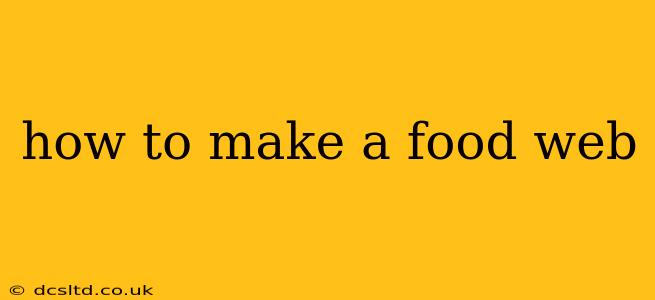How to Make a Food Web: A Comprehensive Guide
Creating a food web is a fantastic way to visualize the complex relationships within an ecosystem. It's more than just a simple food chain; it shows the interconnectedness of multiple food chains, illustrating who eats whom in a given environment. This guide will walk you through the process, from understanding the basics to creating a visually appealing and informative food web.
What is a Food Web?
Before diving into the creation process, let's clarify what a food web represents. A food web is a diagram showing the feeding relationships between different organisms in an ecosystem. Unlike a food chain, which follows a single path of energy transfer, a food web shows multiple interconnected food chains, demonstrating the complex interactions between producers, consumers, and decomposers.
What You'll Need to Create a Food Web
- Paper or digital drawing tool: You can use a piece of paper, a whiteboard, or a digital drawing program like PowerPoint, Google Drawings, or specialized biology software.
- Information about the ecosystem: You'll need to gather information on the organisms that inhabit the ecosystem you're focusing on. This might involve research, field observations, or using existing ecological data.
- Coloring materials (optional): Different colors can help to visually distinguish the various trophic levels (producer, primary consumer, secondary consumer, etc.) and types of organisms in your food web.
Steps to Create Your Food Web
-
Choose your ecosystem: Select a specific ecosystem you want to represent, such as a forest, grassland, pond, or ocean. The more focused your ecosystem, the easier it will be to create a manageable and accurate food web.
-
Identify the organisms: Research the plants and animals that live in your chosen ecosystem. Focus on the key players and their feeding habits. Remember to include producers (plants), consumers (herbivores, carnivores, omnivores), and decomposers (bacteria and fungi).
-
Determine feeding relationships: For each organism, determine what it eats. This involves researching their diet or observing their feeding behavior if you're working with a real-world ecosystem.
-
Draw the food web: Start by drawing the producers (plants) at the bottom of your food web. Then, draw the primary consumers (herbivores) that feed on the producers, connecting them with arrows pointing from the producer to the consumer. Continue this process for secondary consumers (carnivores or omnivores that eat herbivores), tertiary consumers (carnivores that eat other carnivores), and so on.
-
Include decomposers: Don't forget to include decomposers! Draw arrows from all organisms (dead plants and animals) to the decomposers, illustrating how they break down organic matter and return nutrients to the soil.
-
Use arrows to show energy flow: The arrows in your food web should always point in the direction of energy flow – from the organism being eaten to the organism that eats it.
-
Label all organisms: Clearly label each organism in your food web for easy understanding.
H2: What are the different trophic levels in a food web?
A food web is organized into trophic levels, which represent the position of an organism in the food chain. The main trophic levels are:
-
Producers: These are autotrophs (organisms that make their own food), typically plants, that form the base of the food web. They convert sunlight into energy through photosynthesis.
-
Primary Consumers: These are herbivores that eat producers. Examples include rabbits, deer, and grasshoppers.
-
Secondary Consumers: These are carnivores or omnivores that eat primary consumers. Examples include snakes, foxes, and owls.
-
Tertiary Consumers: These are top predators that feed on secondary consumers. Examples include lions, eagles, and sharks.
-
Decomposers: These break down dead organisms and organic waste, returning nutrients to the ecosystem. Examples include bacteria and fungi.
H2: How can I make a food web for a specific habitat, like a forest?
Creating a food web for a specific habitat like a forest involves focusing on the organisms common to that environment. You would begin by identifying the dominant plant life (producers, like trees, shrubs, and grasses). Then, identify the herbivores that feed on these plants (primary consumers, like deer, rabbits, and insects). Next, include the carnivores and omnivores that prey on the herbivores (secondary consumers, like foxes, owls, and snakes). You can continue this process to include tertiary consumers (top predators like wolves or mountain lions) and, of course, decomposers (fungi and bacteria). Remember to connect the organisms with arrows indicating the direction of energy transfer.
H2: What are some examples of organisms that belong in a food web?
Examples vary widely depending on the ecosystem, but here are some common examples across different habitats:
-
Producers: Trees, grasses, algae, phytoplankton
-
Primary Consumers: Grasshoppers, rabbits, deer, zooplankton
-
Secondary Consumers: Frogs, snakes, birds, small mammals
-
Tertiary Consumers: Wolves, lions, eagles, sharks
-
Decomposers: Fungi, bacteria
H2: What is the difference between a food chain and a food web?
A food chain is a linear sequence showing the flow of energy from one organism to another. It shows a single path of energy transfer. A food web, on the other hand, is a complex network showing multiple interconnected food chains. It illustrates the more realistic and intricate relationships within an ecosystem.
By following these steps and incorporating your research, you can create a compelling and informative food web that showcases the intricate connections within any ecosystem. Remember, the more accurate and detailed your research, the more accurate and valuable your food web will be.
